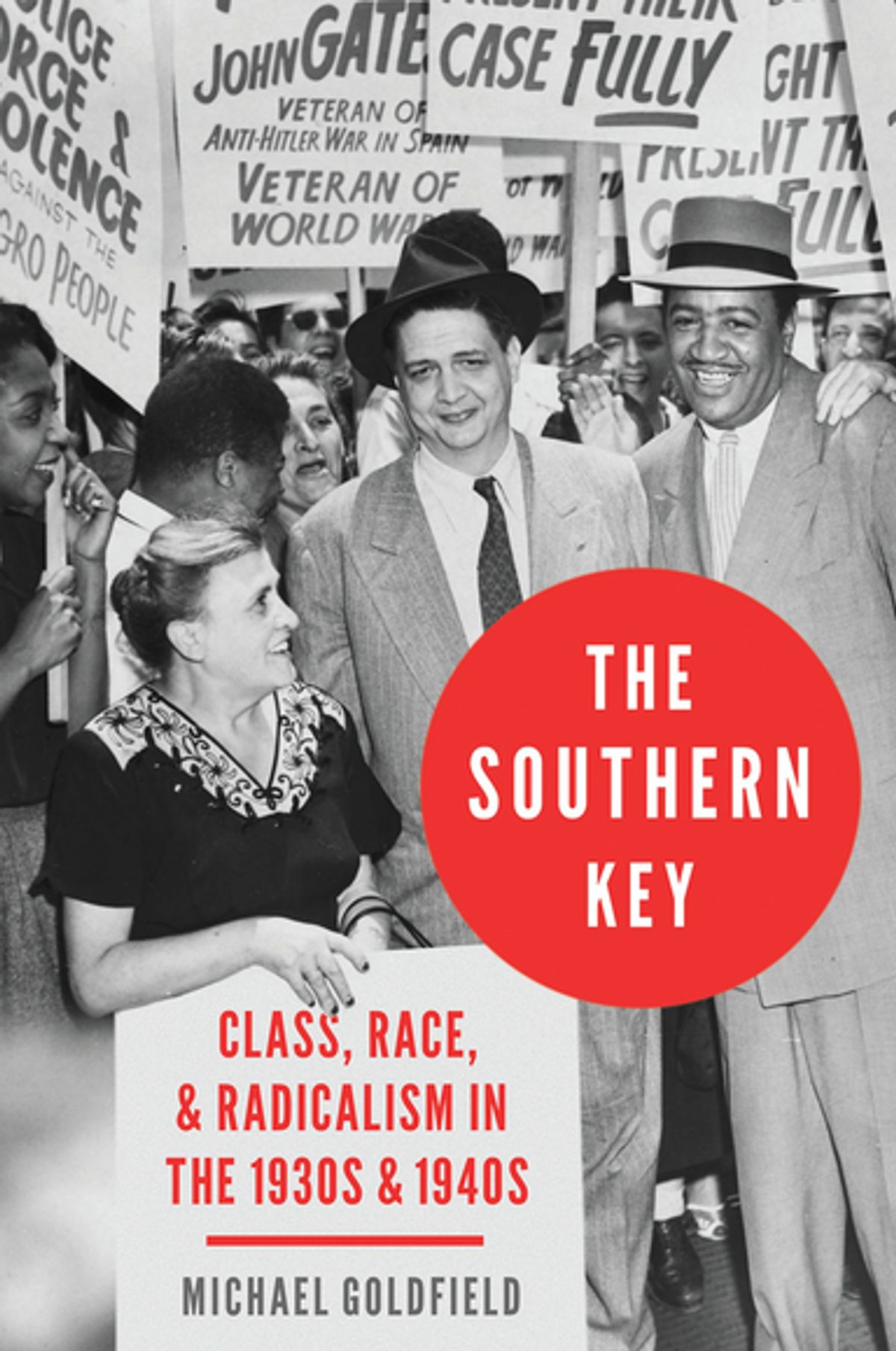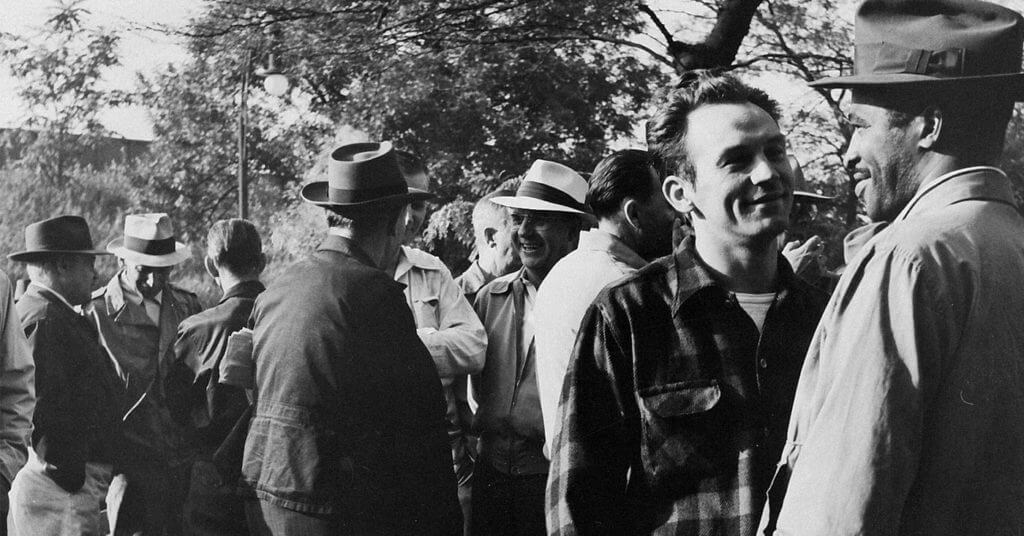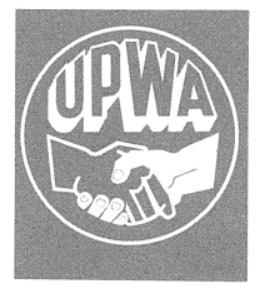This is our final entry for this week’s roundtable discussion on Michael Goldfield’s new book, The Southern Key: Class, Race, and Radicalism in the 1930s and 1940s. Goldfield examines the failure to organize the South in the period of the workers insurgency of the 1930s and 1940s. He argues that the fate of the South determined the fate of the nation, and that unionization was the key to transforming the region. He asks important questions about whether it could have been organized, examining an extensive array of published and archival sources.

We have posted a new contribution to the roundtable each day for most of the week. The four roundtable commentators focused on key themes in Goldfield’s book.
July 13: James Gray Pope discusses the key premises of The Southern Key, suggests the evidence Goldfield presents makes for a usable history, and he suggests they raise important questions about the role of democracy in unions and radical organizations. July 14: Ahmed White focuses on Goldfield’s treatment of the Steelworkers union, and then raises important questions about counterfactuals and repression. July 15: William Jones questions whether Goldfield has addressed the intersection between law and politics adequately, and suggests he neglects the organizing that continued outside the Communist Party orbit. July 16: Rosemary Feurer appreciates Goldfield’s survey of the South through “an organizer’s eye,” especially his discussion of the potential of timber and wood workers, but wishes he had contributed a more sustained discussion of how Left organizing was distinctive. July 17: Michael Goldfield writes a robust rejoinder to the key themes and questions raised by the reviewers.
A Response to Critics by Michael Goldfield

I am honored that four esteemed labor historians, all of whom have done pathbreaking work on the period covered by my recent book have chosen to give thoughtful comments on The Southern Key.
Ahmed White has written the definitive work on the 1937 Little Steel strike. So, I am certainly pleased that he finds my discussion of steel workers “an especially notable accomplishment.” He skillfully summarizes my argument about the initial anti-racist nature of the early organizing and the key role played by leftists, especially Communists, as well as the rapid degeneration of the union and the Murray leadership group into racist, authoritarian practices.
There is a discussion in the book on how the top Communist Party (CP) leadership eventually capitulated to the Murray leadership, glorifying him even as he engaged in despicable practices. My book only scratches the surface on the discussion of the Popular Front period (roughly 1935-9, and the period during World War Two, after the military invasion of the Soviet Union by Nazi Germany, which began June 22, 1941). This sycophantic support by the Communists of the mainstream Congress of Industrial Organizations (CIO) leadership continued after the war in the name of preserving an alleged “center-left” coalition. There are those who have justified the Popular Front, as taking the CP into the mainstream. Others, like Paul Buhle, in his impressive work, have cited the huge advances in the cultural arena. Without denying certain of the gains, I take issue in the book on how the left grew, and to what degree the capitulations of the CP helped destroy left influence, and ultimately the civil rights thrust of the labor movement itself. This is a worthy, extensive debate.
The issue of repression is indeed important, although I do not believe that I minimize it, as White suggests. I give extensive detail on the violent repression of coal miners in West Virginia, which retarded the emergence of the union. In steel, unionists and others were routinely murdered and placed in mental institutions, as bad in Pennsylvania as the South, which I partially document. Despite this violence, unions in these and other industries were often successful. During World War II and afterwards, violent repression had greatly diminished, including in the South. Yet ironically union successes, especially in the South, plummeted, often falling prey to the same techniques of union avoidance, pioneered in the South, that plagued union organizing nationally from the 1970s to today (see my 1987 book Decline of Organized Labor for a summary, and Goldfield and Bromsen 2013). In general, however, I find Ahmed White’s points supportive and worthy of continued exploration.
James Pope has written path breaking work on coal miner organization and strike activity in Pennsylvania before the passage of section of the National Industrial Recovery Act. I was tempted to stop reading Pope’s remarks after the first paragraph, where he calls my earlier book The Color of Politics “..the best single-volume treatment of American political dynamics yet written.” A somewhat different assessment from Will Jones’ evaluation, I might add. So our disagreements are perhaps minor. Sidney Hillman, as I indicate a bit in the book, was indeed more complex than most mainstream CIO leaders. He supported the Soviet Union in the 1920s, was not ideologically anti-communist, and, as Pope indicates, was highly supportive of worker militancy in the early 1930s. Yet, by the time of the 1937 Textile Workers Organizing Committee campaign, he was already committed to bureaucratic solutions and his role as a New Deal insider. I put little credence into his verbal threats to launch a civil war if the Supreme Court overthrew the Wagner Act. Such threats are the stock and trade of conservative labor leaders, from AFL-CIO President Lane Kirkland s demand to repeal of the National Labor Relations Act and returning to class warfare, to similar statements by then United Auto Workers (UAW) union president Douglas Fraser, both in 1984, to the earlier threats even by Samuel Gompers. I think Pope and I, however, ultimately agree on Hillman’s role during the TWOC campaign.
Pope raises two other important questions. The first is a question of the undermining of various left labor struggles and leadership by the national CP leadership. There were, of course, times that local leaders affiliated with the CP ignored these leaders, as sometimes happened in anti-racist struggles in unions where they had influence. Still these directives, often successful, must be traced back to the political degeneration of the Soviet Union and Communist International under Stalin. I discuss some of these important issues in my separate chapter on the Communists, but also in numerous other writings.
The most important question raised by Pope, as well as White and others, is the degree to which interracial unionism (which supported demands for racial equality) could be successful in the South. I think Pope underestimates the possibilities here, saying that this happened in only a few places, winning support from white workers. First, let me stress that nothing is given in advance. Examples run the whole spectrum. Yet, it is clear that the despicable United Steelworkers of America (USWA) alliance with the KKK in Birmingham in their battle with the high percentage African-American Mine Mill, as well as the alliance with and friendships of Operation Dixie officials with white supremacist politicians would never achieve this result.

I note in the book the largely uncontested support by majority white workers at the Louisville International Harvester Corporation plant for militant civil rights activity. The plant was largely organized initially by one Black CP cadre. The CP was also successful as I note in various unlikely places in pushing racial issues, including strikes in Gastonia, NC, and in Harlan County KY, both overwhelming white. They did the same in longshore in the San Francisco area.
I collect stories of Black organizers successfully organizing groups of overwhelmingly white workers. One of my favorites that did not make it into the book, was from the 1930s, when the CP sent 19 year old YCL organizer Charles Hayes (future UPWA leader and U.S, congressman) to putatively racist Cairo, Illinois, to organize 300 white carpenters. He led them out on a strike and was elected to represent them at the Memphis headquarters of the United Carpenters, which had never received a black member. These leftist organizers knew how to speak directly to worker concerns and explain class politics. On the other side of the diversity and identity politics conundrum, I once asked former Chicago African-American CP leader Otis Hyde, why he had joined the party in the early 1930s when the branch was all white. He told me that, aside from the free food, their unemployed organizing was impressive, and their class line made sense. And, there are lots more instances of the above. The key point, however, is that, as Frederick Douglas has told us, “Without struggle, there is no progress.”
Rosemary Feurer stresses a number of important themes of my book, upon which we seem to agree, including the myth of the role of section 7a of the NIRA in propelling coal miner organizing, and on the perfidy of the mainstream, liberal leaders of the CIO. Yet, she claims to be “disappointed” that I did not give greater information and argument for why left-wing organizers would have been more successful in the South. Well, I thought I did talk a bit about this, including the greater success of CPers in the woodworkers, in tobacco, and elsewhere. But, I also wish to demur. I concentrate on only 4 industries and have material on all industries across the country and the South, spending weeks in Boulder going through the Mine Mill archives, time in Denver at the then Oil, Chemical, and Atomic Workers of America headquarters, looking at the ILWU, UPWA, Food and Tobacco workers, etc. These did not make it into the book, which was long enough anyway.
In addition, however, this was Lewis’s assessment which I note, a point that seems to be generally accepted by historians, including Robert Zieger (The CIO,1935-1955). There are many others who have documented this. They include Michael Honey on Memphis, but perhaps most importantly, Feurer’s work itself. Feurer’s piece on the St. Louis female, interracial CP-organized nutpickers’ union is justly famous, and has always been a favorite of my students. Her work on St. Louis in general skillfully documents how the CP-led UE district under William Sentner, organized workers in a secondary market (with some structural power…a central theme of my book) by creating both community and other union alliances to create, powerful, successful coalitions (what I call associational power), something that mainstream CIO leaders were most often reluctant or completely opposed to doing. These types of coalitions which the CPers were especially good at (and they used in the oil worker organizing in Texas, Louisiana, and Oklahoma) were a distinguishing characteristic. District 65 was successful in organizing workers with almost no structural power, by stressing associational support.
Rosemary Feurer also remarks at the end that these unions ultimately failed. Well, this is not strictly true since the ILWU among others seems to be hanging on as a political socially conscious union on the West Coast and in Hawaii. Yet, the history of labor unionism in the U.S., but also world-wide is one of rapid ascents (as in the late 1910s, and the 1930s and 1940s) and slow or rapid descents. We are in the trough of a latter period now and await the next upsurge.
William Jones has written a number of important works, including on the proletarianization of Black woodworkers, a key protagonist in my story, skillfully examining cultural institutions (from barrel houses to Negro baseball) to underscore his thesis. I also laud his support for current unionization efforts, especially those of essential, low-paid workers. Yet, on some important issues, we simply disagree, and on several others, I think he has the facts wrong.
First, let me start with where he is wrong. He claims that “Few historians view laws as the sole or primary cause of union growth.” This is just not true. As I document relatively carefully in my book and in my article (with Cody Melcher) in Labor, virtually all historians view 7a as the sole or primary cause of union growth in the 1930s. It is so universally held that even I once believed it to be true. I quote and cite dozens of people across the political spectrum here (and there are hundreds, if not thousands more). For example, Irving Bernstein says “The passage of 7(a) of the National Industrial Recovery Act was the spark that rekindled the spirit of unionism within American labor.” I discuss the Wagner Act in two articles in the American Political Science Review (1989 and 1990) arguing for the strength of the labor and other social movements in pressing for the passage of legislation and also strengthening and reconfiguring Congress to the left. So, I find it especially strange that Jones thinks I ignore national and local politics, when the reality is that I place different emphases on them than he does.
He talks about Elijah Jackson. I happen to have a whole file drawer of documents and material on him because he is such an outlier. He was one of the few loyal mainstream Black organizers, was active in Operation Dixie, and the most successful by far, especially among African-American woodworkers, as Jones notes. Yet, he was not typical. Ella Baker, as a later mainstay of Southern Christian Leadership Council, and supporter of Student Non-Violent Coordinating Committee, is justly important. But the destruction of the civil rights and CIO alliance is better illustrated by the legacy of the steelworkers in Alabama. As I try to carefully document their racist campaign against Mine Mill in 1948 and 1949 forever poisoned the relation of not just the steel workers, but the CIO in general to Black activists in the whole state of Alabama. This included virtually all NAACP chapters (as Herbert Hill’s secret report to Walter White makes clear) in the state.

The tepidness of these liberal-labor alliances is quite contrary to Jones’ evaluation of them. Aside from the United Packing House Workers of America (UPWA) and 1199:The National Health Care Workers’ Union , and AFSCME, few unions mobilized members in support of civil rights during the 1960s. At the local level, it was left-wing locals, like the FE and the UPWA in Chicago which spearheaded civil rights activities. And in Detroit, it was left-led UAW Local 600, which continued to be the driver until recently.
Seth Wigderson’s highly informative dissertation on the UAW in the 1950s (1989) gives us much important information. Walter Reuther famously marched with Dr. Martin Luther King, but refused to mobilize members or fight racial discrimination in auto plants. He was also in alliance with the NAACP. When this alliance called for integration of bars and restaurants near auto plants, nobody listened. The places that were successfully integrated were near left-wing locals, where interracial demonstrators threw up picket lines and threatened to drive places out of business. Owners there quickly capitulated. The Negro American Labor Council was set up to counter the left-wing National Negro Labor Council. There is little evidence that it mobilized people or achieved what the smaller NNLC did. So, as much as I respect Jones’ other work, I believe he is hanging his hat on some weak reeds here.
Today, the labor movement is weak. Hopefully that will change, and that those of us who support workers’ struggles will have some small part to play. So, as to national and local politics, the movement is the driver and politicians may or may not follow. The movement has recently led to the ouster of more mainstream Democrats, including by some who call themselves socialists. Yet, there is not an organized left or labor movement to hold their feet to the fire. As Robert Brenner documents carefully in his recent article in New Left Review the whole Democratic Party establishment (including virtually all the so-called progressives) capitulated to the Republicans and their corporate donors on the bailout bill, which even the mainstream media has characterized as a corporate giveaway. As Brenner notes, it was only AOC who denounced the bills and refused to vote for them (where were the other members of the Squad?). Bernie has also appeared absent from the scene. My various activities, as well as surprisingly my book (hardly a popular presentation), have put me in touch with a whole range of southern labor organizers, most of whom worked for Bernie Sanders. When they asked Bernie to support them in some of their more intriguing organizing campaigns, he did not appear. I would contrast this attitude with that of Jesse Jackson, when he ran for president in the 1980s and seemed to be appearing on picket lines every day. As I document in the Color of Politics, Jesse won the Michigan Democratic Party primary not only with the Black vote but getting large majorities of white auto workers’ votes, from locals that defied the leaders of the national UAW. So, let me suggest that the actors that we need to look at are not the ones Jones wants to emphasize.
Finally, one advantage that those of us who are labor historians have is that we are able to put certain things in perspective. Little can be predicted, and surprises are always there. As I document at the end of my Decline of Organized Labor, in early 1933, the most eminent labor economists were predicting the end of the labor movement (a bad time for such a prediction). The 1947 Buffalo teachers strike, militant and solidaristic, was crushed with few allies, leading to the passage of the nation’s most repressive public sector worker legislation in the country, the Condon-Wadlin Act. In contrast, the 1960 New York City strike of 50,000 school teachers was the signal event that spurred the organizing of millions of teachers and other governmental workers. And, who could have predicted the upsurge and ubiquitousness of recent Black Lives Matter protests, involving millions, in thousands of towns (under reported of course, in the media). My favorite (being located in Michigan so perhaps provincial) was the march in McComb County’s Sterling Heights, a reputedly racist town even referred to by residents as Stirling Whites. There ten thousand demonstrators marched and shut down the downtown area in support. So, both dangers and hope seem to be imminent. And, we chroniclers, historians, educators, intellectuals, and armchairs, while doing our small part, must wait patiently.
Michael Goldfield is Professor Emeritus of Political Science and currently Research Fellow at the Fraser Center for the Study of Workplace Issues at Wayne State University in Detroit. He is a former labor agitator and the author of hundreds of articles and numerous books on race and labor, including The Southern Key, The Color of Politics, Race and the Mainsprings of American Politics, and The Decline of Organized Labor in the United States.





